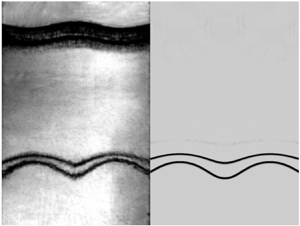Article contents
Hydrodynamic instabilities of two successive slow/fast interfaces induced by a weak shock
Published online by Cambridge University Press: 23 January 2023
Abstract

Shock-induced instability developments of two successive interfaces have attracted much attention, but remain a difficult problem to solve. The feedthrough and reverberating waves between two successive interfaces significantly influence the hydrodynamic instabilities of the two interfaces. The evolutions of two successive slow/fast interfaces driven by a weak shock wave are examined experimentally and numerically. First, a general one-dimensional theory is established to describe the movements of the two interfaces by studying the rarefaction waves reflected between the two interfaces. Second, an analytical, linear model is established by considering the arbitrary wavenumber and phase combinations and compressibility to quantify the feedthrough effect on the Richtmyer–Meshkov instability (RMI) of two successive slow/fast interfaces. The feedthrough significantly influences the RMI of the two interfaces, and even leads to abnormal RMI (i.e. phase reversal of a shocked slow/fast interface is inhibited) which is the first observational evidence of the abnormal RMI provided by the present study. Moreover, the stretching effect and short-time Rayleigh–Taylor instability or Rayleigh–Taylor stabilisation imposed by the rarefaction waves on the two interfaces are quantified considering the two interfaces’ phase reversal. The conditions and outcomes of the freeze-out and abnormal RMI caused by the feedthrough are summarised based on the theoretical model and numerical simulation. A specific requirement for the simultaneously freeze-out of the instability of the two interfaces is proposed, which can potentially be used in the applications to suppress the hydrodynamic instabilities.
JFM classification
Information
- Type
- JFM Papers
- Information
- Copyright
- © The Author(s), 2023. Published by Cambridge University Press
References
REFERENCES
- 21
- Cited by


